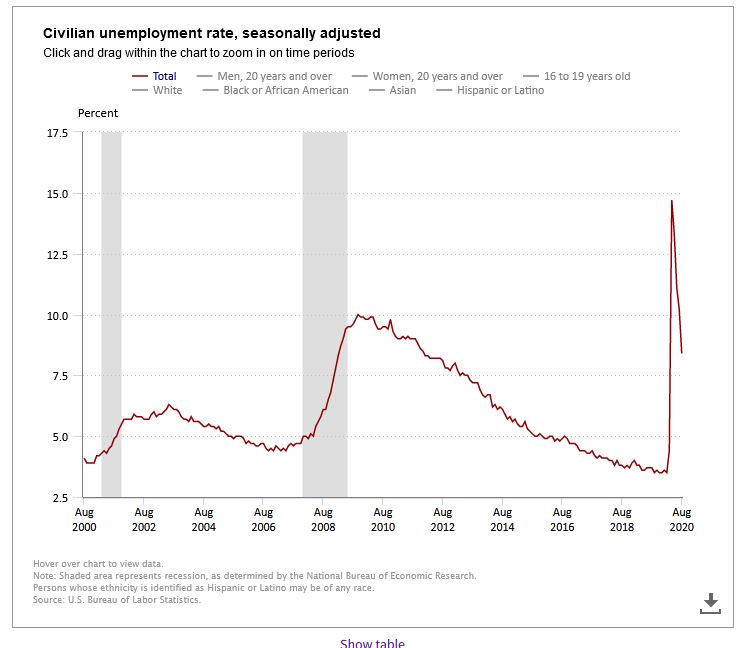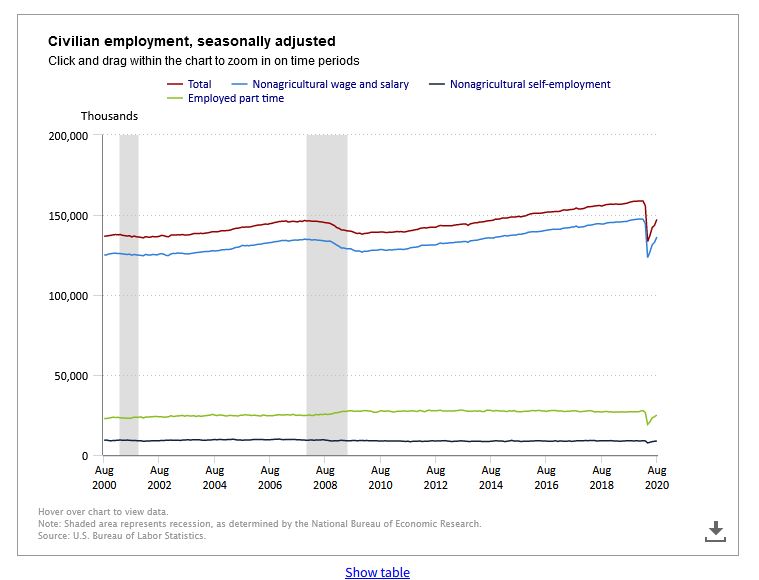Employment Blog September 2020
This report is from the US Department of Labor, Bureau of Labor Statistics. Nonfarm payroll employment increased by 1.4 million in August, and the unemployment rate declined by 1.8 percentage points to 8.4 percent. These improvements reflect the continued resumption of economic activity that had been curtailed due to the coronavirus (COVID-19) pandemic and efforts to contain it. In August, employment rose in several major industry sectors. A gain in government largely reflected the hiring of temporary workers for the 2020 Census. Notable job gains also occurred in retail trade, in professional and business services, in leisure and hospitality, and in education and health services. The August payroll employment increase of 1.4 million followed gains of 1.7 million in July, 4.8 million in June, and 2.7 million in May. As of August, total nonfarm employment is 11.5 million, or 7.6 percent, lower than in February, before the pandemic crisis unfolded in many parts of the United States. Although unemployment fell for the fourth month in a row in August, the unemployment rate and the number of unemployed people are up by 4.9 percentage points and 7.8 million, respectively, since February.


Taking a closer look at the August payroll data, employment in government increased by 344,000, accounting for one-fourth of the over-the-month growth in total nonfarm employment. Federal government employment rose by 251,000, reflecting the hiring of 238,000 temporary workers for the 2020 Census. Local government added 95,000 jobs over the month. Despite these gains, employment in government is 831,000 lower than in February.
Employment in retail trade increased by 249,000 in August. Job growth occurred in most retail industries in August, although almost half of the gain occurred in general merchandise stores (+116,000). Other notable job gains occurred in motor vehicle and parts dealers (+22,000), electronics and appliance stores (+21,000), miscellaneous store retailers (+17,000), and health and personal care stores (+15,000). In August, retail trade employment was 655,000 lower than in February.
In August, professional and business services added 197,000 jobs, with more than half of the gain occurring in temporary help services (+107,000). Elsewhere in the industry, architectural and engineering services (+14,000), computer systems design and related services (+13,000), and business support services (+13,000) added jobs over the month. On net, employment in professional and business services is 1.5 million below its February level.
Employment in leisure and hospitality increased by 174,000 in August, after gains of 621,000 in July and 2.0 million in June. However, employment is 4.1 million lower than in February. Within the industry, food services and drinking places added 134,000 jobs in August, but employment is 2.5 million lower than the February level.
In August, education and health services added 147,000 jobs. Health care employment increased by 75,000, with gains in offices of physicians (+27,000), offices of dentists (+22,000), hospitals (+14,000), and home health care services (+12,000). Elsewhere in health care, job losses continued over the month in nursing and residential care facilities (-14,000), with declinestotaling 229,000 since February. Employment in private education rose by 57,000 in August. Overall, employment in education and health services is down by 1.5 million from February.
Employment in transportation and warehousing increased by 78,000 in August but is down by 381,000 since February. In August, notable job gains occurred in warehousing and storage (+34,000), transit and ground passenger transportation (+11,000), and truck transportation (+10,000).
Employment in the other services industry rose by 74,000 in August, with gains occurring in membership associations and organizations (+31,000), repair and maintenance (+29,000), and personal and laundry services (+14,000). Since February, employment in the other services industry is down by 531,000.
In August, employment in financial activities increased by 36,000 but is 191,000 lower than its February level. Over the month, job gains occurred in real estate and rental and leasing (+23,000) and nondepository credit intermediation (+10,000).
Employment in manufacturing rose by 29,000 in August, with most of the gain occurring in the nondurable goods component (+27,000). Since February, manufacturing employment is down by 720,000.
In August, wholesale trade added 14,000 jobs, with an increase in nondurable goods (+9,000). Employment in wholesale trade is 328,000 lower than its February level.
Construction employment changed little in August (+16,000) but is 425,000 lower than in February. Within specialty trade construction, residential contractors added jobs in August (+25,000), while nonresidential contractors lost jobs (-16,000).
Real average hourly earnings for all employees were unchanged from July to August, seasonally adjusted, the U.S. Bureau of Labor Statistics reported today. This result stems from an increase of 0.4 percent in average hourly earnings offset by an increase of 0.4 percent in the Consumer Price Index for All Urban Consumers (CPI-U). Real average weekly earnings increased 0.3 percent over the month due to no change in real average hourly earnings combined with a 0.3-percent increase in the average workweek.

